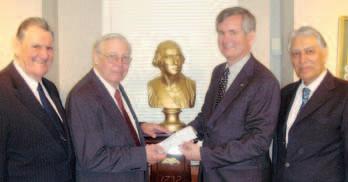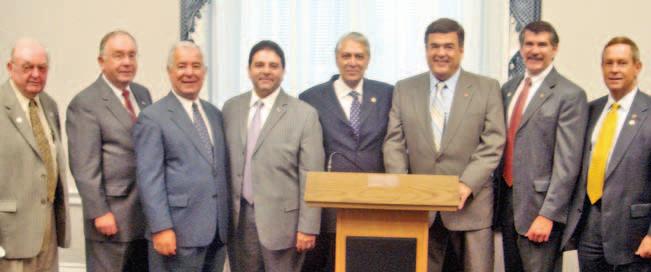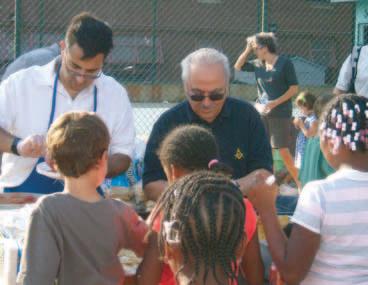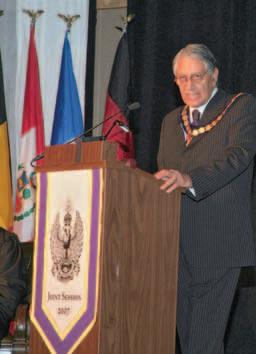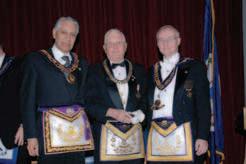
10 minute read
A Decidedly Short History of Temple Noyes Cathedral Lodge No. 32
Editor’s Note on Lodge Histories: This article is the first of a series of articles appertaining to the history of our constituent lodges. It also serves as a call on the Worshipful Masters and historians of our lodges, to share with us the story of the creation of their lodge, old or new, and its journey through time, so that it may be reflected in the pages of the Voice, for posterity.
Jeffrey Schilling
Worshipful Master Temple Noyes Cathedral Lodge No. 32
May 19, 1907 Even in 1907, there was concern about the “ManufacDear Sir: Won’t you come by the New Willard Friday evening May 10th at 8:30 o’clock to meet a few other gentlemen for the purpose of talking over a new Masonic proposition? No formality; don’t answer; just come, if only for a few minutes. ture of Masons for commercial purposes”. In fact, of the candidates (and masons) recruited before petitioning the Grand Lodge for formation, four out of five applicants were rejected. The first lodge began with 81 active members and 26 honorary members. It should be noted that there was some opposition to this “unique lodge” as a Fraternally, result of its perceived (and Thomas C. Noyes. With this short message, the founder and namesake of Temple Noyes Cathedral Lodge No. 32 (TNC 32) began a 100 year history of making good Masons. From the original 17 who met at the Willard to the hundreds of brethren who have received light over the years, TNC 32 still stands May 19, 1907 Dear Sir: Won’t you come by the New Willard Friday evening May 10th at 8:30 o’clock to meet a few other gentlemen for the purpose of talking over a new Masonic proposireal) exclusivity. Due to these principals, still held, TNC 32 has, over the years, been referred to by other fine brothers as the “silkstocking lodge,” which though meant with (presumably affectionate) derision, has become a source of quiet pride among our members. On October 17, 1907, the for the same principals as tion? No formality; don’t name Temple Lodge was put forth in that inaugural meeting. answer; just come, if only adopted and our founder, Thomas C. Noyes was It was agreed then that: 1. “Membership in the for a few minutes. Fraternally, elected as Worshipful Master. We were chartered on December 18, 1907, after Lodge will be limited, so Thomas C. Noyes. which WM Noyes members would have a hosted…”a bounteous more complete acquainrepast at the Willard”. tance with, and a more intimate knowledge of, each other.” Since Temple Lodge was sponsored by Harmony Lodge No. 17, Worshipful Master Noyes appreciatively decreed that from that 2. “Membership in the organization should be made day forward, whenever our Lodge was visited by the more difficult of attainment and maintenance, and sitting Master of Harmony Lodge, he would be therefore more highly prized, by an increase in the received at the alter, with the brethren standing. This fees for initiation and affiliation and the annual dues, tradition was upheld when WM Stephen R. Watkins, so that the means would be supplied for frequent Master of Harmony Lodge No. 17 for 2007 was kind social intercourse among its members and member of enough to represent all those who came before him the fraternity in general.” and was received, recognized and applauded at our February Stated Communication.
April 22, 1909 – Brother (and soon to be President) William Howard Taft entered the West Gate and was presented to the Worshipful Master of Temple Lodge, where he sat in the East for the first section of the Master Masons degree “…happy in tiled security, and in the comradeship of men who meet on the level, act by the plum and part upon the square”. In 1912, WM William Carter Keene noticed that the attendance for the EA and FC degrees “was abysmal”, but recognized that the attendance at past Master Mason degrees was great, due to a lavish feast served after the conferral. Without previous hint, the Master invited the thirty brethren present for the Entered Apprentice degree (half visitors) to accompany him to the Fredonia Hotel “…where the most sumptuous repast in the history of the Lodge was served.” The next day, the answer given to inquiring absentees was the now infamous quote: “It is dangerous to miss a meeting at Temple Lodge!” Thus began the root of our later Lodge tradition, to hold one stated communication and a one separate social gathering, each month, for fraternity and fellowship. TNC 32 members, to this day, continue to gather “on the second Monday” at various public establishments, member homes or other decided venues to share libation, sustenance, Masonic commitment and true fraternal camaraderie, with one another.
In 1922, Temple Lodge helped form Cathedral Lodge due to increasing membership and the desire to conform to the principals set forth by our original Master. The two sister lodges remained separate until 1977 when Temple and Cathedral again merged to form what is known today as Temple Noyes Cathedral Lodge No. 32. Any description of TNC 32 would be incomplete without mentioning three Masons who selflessly mentored our line officers for years: * W.B. William H. Rohrman, whose passion for excellence in Masonic Ritual was surpassed only by his commitment to teaching his fellow Brethren of TNC 32 not just words but also the meaning of Masonry. His life was an example to three generations of TNC members of what is important and special about our Masonic Fraternity. In honor of W.B. William H. Rohrman, a medal bearing his name is worn by each year’s Junior Steward as a reminder of the TNC tradition of learning the valuable lessons of Masonry through excellence in our Fraternity’s Ritual. We, at TNC, are indebted to “Brother Bill” for creating a culture of excellence in Masonic Ritual which continues to be the cornerstone of our Lodge. * W.B. Frank Seale, P.M., who met personally with line officers on Friday nights to teach ritual by word of mouth to many of our incoming officers. His mild mannered persona, congeniality and patient efforts will never be forgotten by those who knew him. * Grand Historian and Right Worshipful Brother Carl R. Levine, P.M., continued the tradition of W.B. Rohrman, and mentored, cajoled, scolded and taught several more generations of line officers to uphold the standards of ritual that have been the hallmark of TNC 32. We remain unaware of anyone who learned from Carl who did not come away a better man and Mason because of it.
In 2007, our membership remains strong with over 175 members. We have celebrated throughout our Centennial year with our traditional Master’s Roast (a significant and often ribald affair), a Valentines Day dance to honor our ladies for their understanding of our fraternal commitments, a Stated Communication where our own PM Alan L. Gordon gave a speech on the history of TNC 32, followed a month later by a speech on the “History of Freemasonry in America” given by our respected brother S. Brent Morris, 33. In May, our brethren gathered for a bus ride around the District of Columbia to view and learn more about the Masonic Memorials and Masonic history of this great city. This historical tour was hosted by our own Brother Bill Garnett and topped off with a “rolling lecture” expertly performed by our friend and mentor RWB Akram R. Elias. We celebrated in April with a “Centennial Oyster Roast and Sporting Clays event” which may hereafter become a traditional affair. We plan to have a River Ride and family picnic in August as well as a Grand Centennial Celebration at Almas Temple in November. These fraternal events, along with our quiet charitable activities and increasingly youthful membership, will most certainly allow us to begin our 2nd century, secure in the knowledge that the Masonic principals we hold dear will lead us proudly into the future. ■

Grand Lodge Leadership Conference continued from page 15
already involved somewhat and there is an initiative underway with American University. Internal Education and Freemasonry Awareness –Ritual instruction has become a focal point of the leaders within the entire DC Lodge system. Discussions led to the decision that each lodge needed to appoint a liaison person(s) to be responsible for Masonic history and education. Such contacts were deemed necessary in order to relay instruction and course material to the lodges from the central source of the Grand Lodge. Deputy Grand Lecturer Chip Mahaney stated that he would like to see a greater emphasis on creating ritual certificate holders, saying that he envisions 10-12 people qualified by 2010 thereby spreading the weight of instruction throughout the system. Brotherhood and Obligation – Group consensus indicated that greater stress should be placed on brotherhood and obligation within the lodges with more emphasis being placed on the fraternal aspect of lodge membership. “We are our “brothers keepers,” as the old adage says, but we have not paid enough attention to obligation as attested by many present at the conference. Such obligation includes informative and substantive reminders and explanations of such organizations as the Grand Lodge Foundation or the activity of MESH. Commitments and Focal Points: Moving past the “talking stage” and towards “action,” the Brethren agreed to bring back to their respective lodges the following: 1. Education – project of adopting a public school to be identified by December 15, 2007 2. Lodge Development – the names of a ritual instructor and educational instructor to be identified by December 31, 2007. Work to begin in
January, 2008. 3. Outreach – to a civic organization by December 3. 4. Adopt a university fraternity by May, 2008. 5. Brotherhood Obligation – get to know every
Brother in Lodge by the first Communication of
Executive Meeting following installation.
Leadership Course
A second and highly important part of the conference was the facilitation of a brief leadership training course by the well-known author, trainer and Brother Dan Goldberg who is the author of a well respected book Lighten up and Lead (AuthorHouse: Bloomington, IN, 2007). Using the techniques outlined in the book, Brother Goldberg led the group through a process of self-examination using standard leadership training materials in order to identify leadership traits. Most of the training was in the nature of selfevaluation and self-knowledge. As a time-saver, much of the book was paraphrased; but his training book is a good place to begin the process of self-learning leadership core principles. The basis for this approach is realizing that the key to leadership is an understanding of oneself first, then recognizing specific behavior traits in others. To create group participants and delegation, one must first place the request into the other person’s world. Only when the other person take possession and embraces it as “his own” will the task be accomplished and the energy of the group be increased thereby. Among the analytical techniques, for instance, was an exercise to determine if the people leaned toward the introverted or extroverted style of leadership. There being no sharp break between the two poles; many people have some traits of each but Goldberg emphasized that several identifiable characteristics can be associated with each type. Leaders should learn to determine which members of their leadership team fall within each quality and gauge the work assignments and tasks accordingly. Another useful tool was used in determining if a person leaned toward the theoretical or the utilitarian—what motivates them and which tasks are best suited to each type.
More trait delineations of leaders and those they seek to lead were covered in sessions dealing with a behavioral self-assessment, attitudinal self-assessment, and a review of the seven elements of successful leadership (communications, managing change, setting goals, time management, team building, delegation, and motivation). Brother Goldberg prepared a thorough training manual that included several templates for project and personnel management. It should be possible for anyone interested in the conference but unable to attend to acquire or consult a copy at the Grand Lodge. Lighten up and Lead is a text containing very useful approach and includes a multitude of templates which, together with the course materials, could be used within the lodge for leadership activity including several example sheets for use in training exercises. In conclusion, it is interesting to note that many members at the leadership conference came with the

